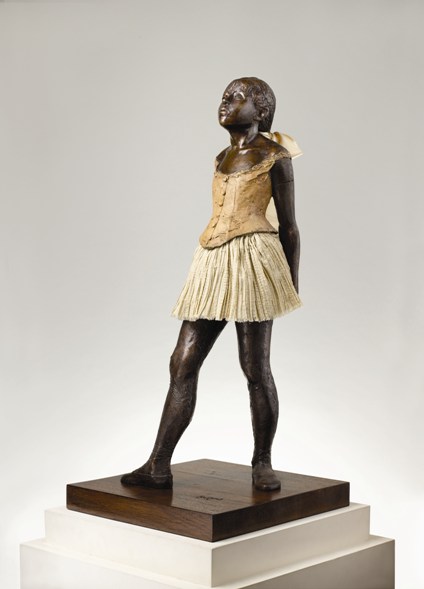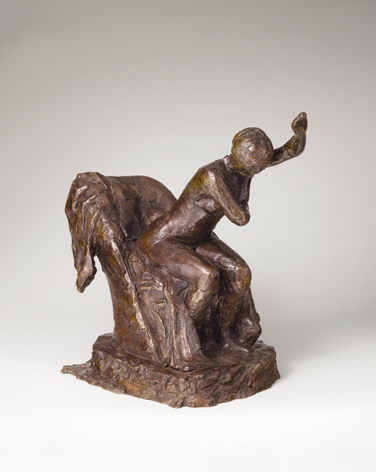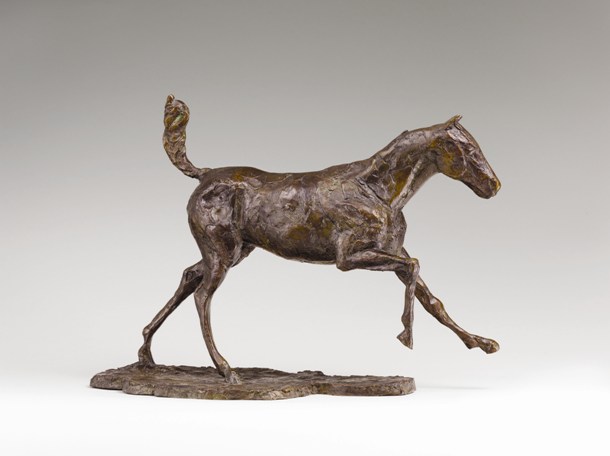
Beauty and controversy come to the Tel Aviv Museum of Art with The Sculpture of Degas, curated by Museum Director Professor Mordechai Omer. The exhibit of 74 sculptures in bronze by Edgar Degas (1834 – 1917) cast from previously unknown plasters will be open to the public from March 26.
Beauty
Entering the exhibit, The Little Dancer faces the viewer, chin up, leg extended, with all the tension and arrogance of adolescence. The sculptures have been arranged according to themes, beginning with dancers. The exhibit design is visually appealing, with sculptures set on warm yellow pedestals, and generously spaced, inviting the viewer to approach and appreciate these detailed bronzes.
Degas’ involvement with the body and motion is the essence of this exhibit, at once a sensual experience to be savored and an opportunity to study the artist more closely. In the second room three small sculptures are set on a shelf, just below eye level, creating an atmosphere of intimacy – you can almost feel Degas’ hands working the wax. The immediacy and tactile quality of the exhibit is enhanced by the presence of sculptures cast from works such as the figure of a woman bowing, the expressive body rough, unfinished, limbs thick, and her head heavy and large – the raw material of movement.
Seven dancers almost seem to move, set on a round table in the center of the room, their black shadows dancing on the yellow ochre background. The beautiful display is also very user-friendly for those who want to study the exhibit in depth. The exhibit is arranged according to theme: dancers, dancers backstage, women, horses, bathers, a fragment from the bas relief Picking Apples, and busts. Augmenting the sculptures are three paintings from the museum’s permanent collection, and accompanying the texts in each room are reproductions of Degas’ drawings which provide another visual approach to his artistic perspective and process.

While Degas’ attitude towards women has been much discussed by critics and scholars, his attention to the female body and sensitivity to its nuances is undeniable. Looking at the sculpture Pregnant Woman you can see the shift in her center of gravity, one of the physical aspects of advanced pregnancy. While sculptures such as Seated Woman in an Armchair, Wiping Her Left Arm-pit, might be open to accusations of voyeurism and obsession, a close examination of Degas’ work suggests a more complex although certainly intimate involvement. A reproduction of Degas’ sketch of Rodin’s sculpture Eve is faithful to the original, showing a woman turned inward, arms folded across her chest, immobile in her shame, passive. Degas’ sculpture, while referring to a similar context, creates a very different effect. Degas’ Eve spirals outward, her hands reach down toward her genitals, but the reaching movement leaves her breasts exposed, open space between her bent arms and torso. Her legs are splayed, knees bent, as she turns her face away from the viewer, one might imagine her about to flee. This woman may have been caught and shamed, but her stance implies the possibility of action.
The small bas relief and sculpted portraits reveal additional aspects of Degas’ work, as does the quoted sonnet dedicated to opera singer Rose Caron, known for her graceful movement. As Museum Director Prof. Omer says, “Degas was always involved with the medium.”
Controversy
Degas’ sculptures have always had an aura of mystery about them. The only sculpture exhibited by Degas is that of The Little Dancer, Aged Fourteen, whose wax original was shown at the 1881 Sixth Impressionist Exhibition in Paris, to critical derision. 150 wax sculptures in varying states of completion were found in the artist’s studio after his death. There is an artistic debate concerning Degas’ intentions – some claim that they were part of his process, aids to the paintings never intended to be exhibited as finished works of art; others believe that Degas was offended by the criticism of The Little Dancer and thereafter reluctant to exhibit the sculptures. Degas had plasters made of the wax originals but they were not cast in bronze.
After his death, Degas’ heirs arranged for 74 sculptures to be cast at the Hébrard Foundary. The first set was purchased in 1921 by the American collector Louisine Havemeyer at the urging of American Impressionist artist Mary Cassatt (1844 – 1926) who wrote: “I have studied Degas’ bronzes for months. I believe he will live to be greater as a sculptor than as a painter.” (from “Degas the Sculptor” by Walter F. Maibaum) This set was bequeathed to the Metropolitan Museum of Art in New York in 1929. The Hébrard Foundary continued to cast bronzes until 1936, but although this marked the closing of a chapter, the story of Degas’ bronzes does not end here.

Nelly Hébrard (daughter of the owner) kept the action alive with a series of surprising announcements. Acquiring certain rights to cast bronzes in 1949, in 1955 she revealed that 69 of Degas’ original waxes had survived the casting process in addition to The Little Dancer wax which was previously known to have survived and the plaster Torso. She also disclosed that two plaster sculptures had been made of The Little Dancer in 1921. These are currently located in the National Gallery and the Joslyn Art Museum in Omaha. Another revelation took place in 1976 when a second set of bronzes owned by Nelly Hébrard was exhibited by the Lefevre Gallery in London, each stamped with the word Modèle (French for model). Currently owned by the Norton Simon Museum of Art in Pasadena, California, this set was determined by Arthur Beale to be a master set from which all the other bronzes in museums and private collections have been cast.
For Walter Maibaum, the latest chapter in the Degas mystery began with a phone call from Lawrence Saphire informing him that a new bronze edition of The Little Dancer was being cast. As the existing plasters were in museums, this did not seem possible. Taking off for France with his wife Carol Conn and Saphire to investigate further, Maibaum eventually found a third plaster, and its owner, Leonardo Benatov, owner of the Valsuani Foundary. While the plaster differed in several aspects from the known plasters, Maibaum determined that it could not be a copy, for a forger would have taken great pains to replicate the original in every detail, and according to Maibaum, “the figure’s structure and anatomy was perfect.”
The drama arrived at its climax two years later, when Benatov led Maibaum and Conn to a locked room at the foundary where they saw a room with 74 Degas plasters. Says Maibaum,“It was a shocking sight. To me it was the equivalent of opening King Tut’s tomb in Egypt or uncovering the terra cotta warriors in China. The moment I gazed upon these remarkable plasters I instantly knew that everything that had been written about Degas’ sculptures in the past had to be reconsidered.” Maibaum’s research, in conjunction with independent research conducted by Dr. Gregory Hedberg, Director of European Art for Hirschl & Adler Galleries in New York, indicates that all but two of these plasters were made in Degas’ lifetime.
The current exhibit at the Tel Aviv Museum consists of bronzes cast from these plasters, a process which is more faithful to the original than casting from the bronze model, as had been done with previous editions of the sculptures. There is a 2 -3% shrinkage and loss of detail during the cooling process of the bronze, so that a bronze cast from the plaster would be closer to the original than one cast from a bronze model – as each successive bronze casting results in a loss of detail.
As might be expected with such a discovery, the authenticity of the plasters has been a hot topic of discussion in the art world. An article in The Art Newspaper, quotes Tel Aviv Museum Director and exhibit curator Prof. Mordechai Omer saying that he is “firmly convinced that they and the resulting bronzes are authentic”.
The encounter with such a plentiful body of Degas’ work, in its fascination with movement and the intimate moment, its dedicated, almost obsessive involvement with process, and tactile sensuality is an experience that should be savored more than once.
The Sculpture of Edgar Degas, Simon and Marie Jaglom Pavilion, Tel Aviv Museum of Art
27 Shaul HaMelech Blvd, Information: 03-6077020
Closed Sunday, Mon, Wed, Sat 10:00 – 16:00, Tues, Thurs: 10:00 – 22:00, Fri 10:00 – 14:00
Gallery talks: 1.4 at 11:30, 8.4 at 20:00, 29.4 at 20:00
The bronzes are on loan courtesy of The Degas Sculpture Project, Ltd., whose curators are Walter Maibaum and Carol Conn. The exhibition and catalogue are sponsored by M. T. Abraham Center for the Visual Arts, The French Embassy in Israel, the French Institute, and the French Committee of the Friends of the Tel Aviv Museum of Art.
AYELET DEKEL





